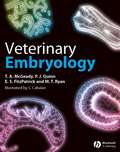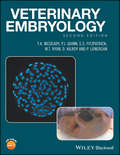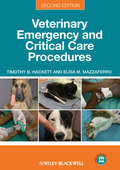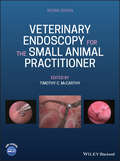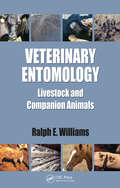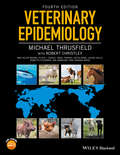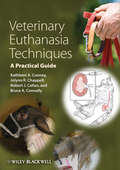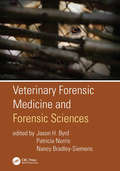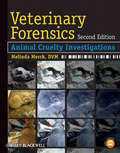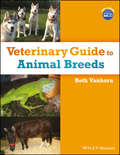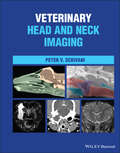- Table View
- List View
Veterinary Embryology
by T. A. McGeady P. J. Quinn E. S. Fitzpatrick M. T. RyanA thorough appreciation of the cellular, molecular and tissue changes which precede the birth of an animal is a fundamental requirement for understanding normal structural development and also abnormal processes which result in congenital defects. This textbook provides information relevant to many subjects taught in preclinical, paraclinical and clinical years. Early chapters describe and explain sequential events relating to the division, growth and differentiation of cells and to the formation of foetal membranes, implantation and placentation. Succeeding chapters trace the origin, growth, development and maturation of the major body systems. Age determination of the embryo and foetus is reviewed in a single chapter. Genetic, chromosomal and environmental factors which adversely affect pre-natal development are reviewed in the final chapter. A reading list at the end of each chapter offers additional sources of information on the topics discussed. Tables, flow diagrams and numerous hand-drawn illustrations provide information in a form which complements the concepts presented in the text. Key features: Written by a team which includes members with expertise in developmental anatomy, molecular biology and clinical aspects of veterinary medicine. The authors have extensive experience in the teaching of veterinary embryology and cognate subjects. Illustrations, hand-drawn by a veterinary graduate, are used extensively to explain organogenesis and system development. An explanatory glossary provides concise information on specialised terms used in the text. The index is designed for easy retrieval of information.
Veterinary Embryology
by T. A. McGeady P. J. Quinn E. S. Fitzpatrick M. T. Ryan D. Kilroy P. LonerganVeterinary Embryology, 2nd Edition, has been updated to reflect the many changes that have developed in the field; the text has been fully revised and expanded and is now in full colour and many pedagogical features and a companion website have been developed. A new edition of this highly successful student textbook, updated to reflect the latest developments in the field of embryology, with the inclusion of four new chapters Written by a team of authors with extensive experience of teaching this subject Short concise chapters on key topics describe complex concepts in a user-friendly way Additional tables, flow diagrams and numerous hand-drawn illustrations support the concepts presented in the text
Veterinary Embryology
by T. A. McGeady P. J. Quinn E. S. Fitzpatrick M. T. Ryan D. Kilroy P. LonerganVeterinary Embryology, 2nd Edition, has been updated to reflect the many changes that have developed in the field; the text has been fully revised and expanded and is now in full colour and many pedagogical features and a companion website have been developed. A new edition of this highly successful student textbook, updated to reflect the latest developments in the field of embryology, with the inclusion of four new chapters Written by a team of authors with extensive experience of teaching this subject Short concise chapters on key topics describe complex concepts in a user-friendly way Additional tables, flow diagrams and numerous hand-drawn illustrations support the concepts presented in the text
Veterinary Emergency and Critical Care Procedures
by Timothy B. Hackett Elisa M. MazzaferroVeterinary Emergency and Critical Care Procedures, Second Edition is a step-by-step guide to key emergency and critical care procedures encountered in both general and specialty practice. Now in full color, the second edition includes several new procedures, two new chapters covering cardiopulmonary resuscitation and continuous rate infusions, and a companion website offering videos demonstrating most of the procedures featured in the book. Helpful hints have also been added throughout to make the book even more useful in the practice setting. Each procedure includes information on the background, supplies needed, indications, and contraindications, followed by a series of images demonstrating the technique. This practical resource, ideally designed for use in fast-paced emergency situations, is an indispensable reference for any member of the veterinary team.
Veterinary Emergency and Critical Care Procedures, Enhanced Edition
by Timothy B. Hackett Elisa M. MazzaferroVeterinary Emergency and Critical Care Procedures, Second Edition is a step-by-step guide to key emergency and critical care procedures encountered in both general and specialty practice. Now in full color, the second edition includes several new procedures, two new chapters covering cardiopulmonary resuscitation and continuous rate infusions, and a companion website offering videos demonstrating most of the procedures featured in the book. Helpful hints have also been added throughout to make the book even more useful in the practice setting. Each procedure includes information on the background, supplies needed, indications, and contraindications, followed by a series of images demonstrating the technique. This practical resource, ideally designed for use in fast-paced emergency situations, is an indispensable reference for any member of the veterinary team.
Veterinary Endoscopy for the Small Animal Practitioner
by Timothy C McCarthy DvmVeterinary Endoscopy for the Small Animal Practitioner, Second Edition, gives veterinarians guidance in incorporating diagnostic endoscopy, interventional endoscopy, and minimally invasive soft tissue surgery into their small animal practices. This highly practical reference supports practitioners in adding and effectively using endoscopy techniques in their practices. With a clinically oriented approach, it focuses on applications for rigid and flexible endoscopy, making comprehensive information on these techniques easily accessible. The book covers soft tissue endoscopy, including airway endoscopy, gastrointestinal endoscopy, diagnostic and operative laparoscopy, diagnostic and operative thoracoscopy, urogenital endoscopy, and otoscopy. Thousands of images, including endoscope images and clinical photographs, enhance the text. Covers diagnostic endoscopy, interventional endoscopy, and minimally invasive soft tissue surgery Includes thousands of images to illustrate endoscopy concepts for veterinarians Provides a clinically oriented reference book for using rigid and flexible endoscopy in a small animal practice Supports veterinarians who are seeking to increase their services and enhance their revenue streams Any practitioner who is using or preparing to use endoscopic techniques will find Veterinary Endoscopy for the Small Animal Practitioner an essential practice resource.
Veterinary Endoscopy for the Small Animal Practitioner
by Timothy C. McCarthyVeterinary Endoscopy for the Small Animal Practitioner, Second Edition, gives veterinarians guidance in incorporating diagnostic endoscopy, interventional endoscopy, and minimally invasive soft tissue surgery into their small animal practices. This highly practical reference supports practitioners in adding and effectively using endoscopy techniques in their practices. With a clinically oriented approach, it focuses on applications for rigid and flexible endoscopy, making comprehensive information on these techniques easily accessible. The book covers soft tissue endoscopy, including airway endoscopy, gastrointestinal endoscopy, diagnostic and operative laparoscopy, diagnostic and operative thoracoscopy, urogenital endoscopy, and otoscopy. Thousands of images, including endoscope images and clinical photographs, enhance the text. Covers diagnostic endoscopy, interventional endoscopy, and minimally invasive soft tissue surgery Includes thousands of images to illustrate endoscopy concepts for veterinarians Provides a clinically oriented reference book for using rigid and flexible endoscopy in a small animal practice Supports veterinarians who are seeking to increase their services and enhance their revenue streams Any practitioner who is using or preparing to use endoscopic techniques will find Veterinary Endoscopy for the Small Animal Practitioner an essential practice resource.
Veterinary Entomology: Livestock and Companion Animals
by Ralph E. WilliamsLivestock production systems and some husbandry practices are prone to producing veterinary important entomological concerns. In addition, various arthropod-borne diseasessuch as West Nile and some types of encephalitiscan affect both humans and animals. To circumvent these problems successfully, a solid understanding of veterinary entomology shoul
Veterinary Epidemiology
by Michael ThrusfieldA comprehensive introduction to the role of epidemiology in veterinary medicine This fully revised and expanded edition of Veterinary Epidemiology introduces readers to the field of veterinary epidemiology. The new edition also adds new chapters on the design of observational studies, validity in epidemiological studies, systematic reviews, and statistical modelling, to deliver more advanced material. This updated edition begins by offering an historical perspective on the development of veterinary medicine. It then addresses the full scope of epidemiology, with chapters covering causality, disease occurrence, determinants, disease patterns, disease ecology, and much more. Veterinary Epidemiology, Fourth Edition: ● Features updates of all chapters to provide a current resource on the subject of veterinary epidemiology ● Presents new chapters essential to the continued advancement of the field ● Includes examples from companion animal, livestock, and avian medicine, as well as aquatic animal diseases ● Focuses on the principles and concepts of epidemiology, surveillance, and diagnostic-test validation and performance ● Includes access to a companion website providing multiple choice questions Veterinary Epidemiology is an invaluable reference for veterinary general practitioners, government veterinarians, agricultural economists, and members of other disciplines interested in animal disease. It is also essential reading for epidemiology students at both the undergraduate and postgraduate levels.
Veterinary Epidemiology
by Michael ThrusfieldA comprehensive introduction to the role of epidemiology in veterinary medicine This fully revised and expanded edition of Veterinary Epidemiology introduces readers to the field of veterinary epidemiology. The new edition also adds new chapters on the design of observational studies, validity in epidemiological studies, systematic reviews, and statistical modelling, to deliver more advanced material. This updated edition begins by offering an historical perspective on the development of veterinary medicine. It then addresses the full scope of epidemiology, with chapters covering causality, disease occurrence, determinants, disease patterns, disease ecology, and much more. Veterinary Epidemiology, Fourth Edition: ● Features updates of all chapters to provide a current resource on the subject of veterinary epidemiology ● Presents new chapters essential to the continued advancement of the field ● Includes examples from companion animal, livestock, and avian medicine, as well as aquatic animal diseases ● Focuses on the principles and concepts of epidemiology, surveillance, and diagnostic-test validation and performance ● Includes access to a companion website providing multiple choice questions Veterinary Epidemiology is an invaluable reference for veterinary general practitioners, government veterinarians, agricultural economists, and members of other disciplines interested in animal disease. It is also essential reading for epidemiology students at both the undergraduate and postgraduate levels.
Veterinary Ethics in Practice
by Dr James W YeatesVeterinary Ethics in Practice gives non-specialist veterinary professionals an introduction to ethics. It helps readers to think about, and discuss, ethical dilemmas and viewpoints faced by practitioners in their daily practice. The book: · Is an important primer and introduction to basic ethical dilemmas. · Helps improve ethical reasoning, through the use of numerous worked examples, leading to increased confidence in decisions and actions. · Explains key ethical concepts and terminology making the subject easier to understand. · Contains case studies which help bring real dilemmas to life. With carefully crafted themes and problem cases in farm animal, companion animal, equine, wildlife, zoo and laboratory settings, the book provides an important yet concise and accessible introduction to moral decision-making in veterinary practice.
Veterinary Euthanasia Techniques: A Practical Guide
by Kathleen A. Cooney Jolynn R. Chappell Robert J. Callan Bruce A. ConnallyVeterinary Euthanasia Techniques: A Practical Guide provides detailed guidance on euthanasia procedures in a wide variety of species, including dogs, cats, exotics, horses, and production animals. Based on the current AVMA guidelines, the book offers step-by-step descriptions of the recommended methods of euthanasia, giving all the information needed to perform these techniques with confidence. Veterinary Euthanasia Techniques helps practitioners, students, and technicians expand their knowledge base and provide competent, compassionate euthanasia services. Including information on client considerations, equipment, positioning, sedation, and aftercare, the focus of the book is on providing detailed procedures for correctly performing euthanasia. Veterinary Euthanasia Techniques presents complete information on euthanasia, offering specific advice to improve skills and aid in decision making.
Veterinary Euthanasia Techniques: A Practical Guide
by Kathleen A. Cooney Jolynn R. Chappell Robert J. Callan Bruce A. ConnallyVeterinary Euthanasia Techniques: A Practical Guide provides detailed guidance on euthanasia procedures in a wide variety of species, including dogs, cats, exotics, horses, and production animals. Based on the current AVMA guidelines, the book offers step-by-step descriptions of the recommended methods of euthanasia, giving all the information needed to perform these techniques with confidence. Veterinary Euthanasia Techniques helps practitioners, students, and technicians expand their knowledge base and provide competent, compassionate euthanasia services. Including information on client considerations, equipment, positioning, sedation, and aftercare, the focus of the book is on providing detailed procedures for correctly performing euthanasia. Veterinary Euthanasia Techniques presents complete information on euthanasia, offering specific advice to improve skills and aid in decision making.
Veterinary Forensic Medicine and Forensic Sciences
by Jason H. Byrd Patricia Norris Nancy Bradley-SiemensWhile there are several recent books on this emerging field, Veterinary Forensic Medicine and Forensic Sciences sets the bar, covering all relevant aspects in a succinct, easy-to-read, comprehensive format designed to be taught in a single-semester course. Intended to be the premier textbook on veterinary forensic sciences, the book covers the application of veterinary forensic medicine to cases, including the medical perspective as well as law enforcement response, crime scene management, and evidence recovery issues. Coverage includes the scientific and legal principles for veterinary forensic evidence. This clearly delineates it from veterinary-only practices, since the forensic aspects present additional challenges that include evidence recovery and preservation, report writing, and maintaining an evidentiary chain of custody, all the way through expert witness testimony. Some emerging topics that are covered include DNA and genetic evidence, entomological evidence in support of veterinary forensics, animal fighting, situational deaths, including poisonings, domestic violence, and cruelty, sharp and blunt force trauma, gunshot and wound ballistics, sexual assault, nonhuman odontology and osteology, and more. Features Details a process for forensic science case management for humane law enforcement agencies Presents multiple chapters on specific types of trauma analysis in animals Provides developments on current trends in forensic entomology as applied to wildlife crime and minimum postmortem interval determinations Explores national and international considerations in combating organized animal fighting Offers DNA applications for wildlife crime and environmental monitoring Outlines current animal and environmental forensic toxicology legal casework This text offers a straightforward presentation of current practices and includes several real-world case examples throughout to illustrate concepts. Fully illustrated with more than 280 full-color images, Veterinary Forensic Medicine and Forensic Sciences provides the latest in advances and up-to-date field techniques, applicable for student instruction in the classroom and beyond.
Veterinary Forensic Medicine and Forensic Sciences
by Jason H. Byrd Patricia Norris Nancy Bradley-SiemensWhile there are several recent books on this emerging field, Veterinary Forensic Medicine and Forensic Sciences sets the bar, covering all relevant aspects in a succinct, easy-to-read, comprehensive format designed to be taught in a single-semester course. Intended to be the premier textbook on veterinary forensic sciences, the book covers the application of veterinary forensic medicine to cases, including the medical perspective as well as law enforcement response, crime scene management, and evidence recovery issues. Coverage includes the scientific and legal principles for veterinary forensic evidence. This clearly delineates it from veterinary-only practices, since the forensic aspects present additional challenges that include evidence recovery and preservation, report writing, and maintaining an evidentiary chain of custody, all the way through expert witness testimony. Some emerging topics that are covered include DNA and genetic evidence, entomological evidence in support of veterinary forensics, animal fighting, situational deaths, including poisonings, domestic violence, and cruelty, sharp and blunt force trauma, gunshot and wound ballistics, sexual assault, nonhuman odontology and osteology, and more. Features Details a process for forensic science case management for humane law enforcement agencies Presents multiple chapters on specific types of trauma analysis in animals Provides developments on current trends in forensic entomology as applied to wildlife crime and minimum postmortem interval determinations Explores national and international considerations in combating organized animal fighting Offers DNA applications for wildlife crime and environmental monitoring Outlines current animal and environmental forensic toxicology legal casework This text offers a straightforward presentation of current practices and includes several real-world case examples throughout to illustrate concepts. Fully illustrated with more than 280 full-color images, Veterinary Forensic Medicine and Forensic Sciences provides the latest in advances and up-to-date field techniques, applicable for student instruction in the classroom and beyond.
Veterinary Forensic Pathology, Volume 1
by Jason W. BrooksThis richly illustrated two-volume book offers a comprehensive and essential reference guide for veterinary pathologists and clinical veterinarians interested in performing animal necropsies for forensic casework. It presents a broad range of animal crime cases, with particular focus on the post mortem examination and the observed pathology. This first volume introduces readers to veterinary forensics and the role of the veterinary pathologist in animal crime investigations. It guides them through the process of evidence collection and documentation, and covers the fundamentals of forensic necropsy and the estimation of time since death. In-depth descriptions of how to conduct the forensic evaluation of various traumatic injuries, firearm injuries, and asphyxia are also provided.
Veterinary Forensic Pathology, Volume 2
by Jason W. BrooksThis richly illustrated two-volume book offers a comprehensive and essential reference guide for veterinary pathologists and clinical veterinarians interested in performing animal necropsies for forensic casework. It presents a broad range of animal crime cases, with particular focus on the post mortem examination and the observed pathology . This second volume guides readers through the forensic evaluation of animal deaths caused by drowning, fire, electrical, and environmental injuries, poisoning, animal fighting, neglect, and sexual abuse. In addition, it offers practical advice on evaluating anesthesia-related deaths, age estimation, and how to write the necropsy report.
Veterinary Forensics: Animal Cruelty Investigations
by Melinda D. MerckVeterinary Forensics, Second Edition is a practical reference on applying veterinary forensic findings in animal cruelty cases. Now providing a greater focus on findings in animals, the second edition continues to offer guidance with more detailed information on crime scene investigation, forensic testing and findings, handling evidence, and testifying in court. Key changes to the new edition include new chapters on abuse in large animals, poultry, and birds; a standalone chapter on entomology; a new section on large scale cruelty investigation; an expanded section on pain and suffering; more pathology information; and more photos, forms, and information throughout. Logs and workbooks from the book are available on a companion website at www.wiley.com/go/vetforensics, allowing readers to download, customize, and use these forms in forensics investigations. Veterinary Forensics is an essential resource for veterinarians, pathologists, attorneys, and investigators working on animal abuse cases.
Veterinary Forensics: Animal Cruelty Investigations
by Melinda D. MerckVeterinary Forensics, Second Edition is a practical reference on applying veterinary forensic findings in animal cruelty cases. Now providing a greater focus on findings in animals, the second edition continues to offer guidance with more detailed information on crime scene investigation, forensic testing and findings, handling evidence, and testifying in court. Key changes to the new edition include new chapters on abuse in large animals, poultry, and birds; a standalone chapter on entomology; a new section on large scale cruelty investigation; an expanded section on pain and suffering; more pathology information; and more photos, forms, and information throughout. Logs and workbooks from the book are available on a companion website at www.wiley.com/go/vetforensics, allowing readers to download, customize, and use these forms in forensics investigations. Veterinary Forensics is an essential resource for veterinarians, pathologists, attorneys, and investigators working on animal abuse cases.
Veterinary Forensics: Investigation, Evidence Collection, and Expert Testimony
by Ernest Rogers Adam W. SternVeterinary Forensics: Investigation, Evidence Collection, and Expert Testimony will provide anyone involved in an investigation of an animal involved crime or civil action with the knowledge and tools that can give guidance for their actions in completing a forensic investigation. All 50 U.S. states, and numerous countries around the world, have laws against animal abuse and cruelty. Law enforcement agents, veterinarians, the judiciary, attorneys and forensic scientists may be involved in cases of animal cruelty, neglect or human crimes that may have an animal element. Additionally, the animal can be the victim, suspect or in some instances the witness of a crime. Given that acquittal or conviction is dependent upon the nature and veracity of the evidence, the quality of the evidence in an animal-related crime investigation must be beyond reproach. The book begins with a discussion of animal abuse and crimes against animals, crime scene investigation, and, from there, discusses various types of forensic examinations of the animal, culminating in a review of the judicial system and testimony in a court of law. All contributing authors are practicing professionals in law, veterinary medicine, and the private sector who provide current, best-practice evidence collection and forensic techniques. Chapters provide in-depth detail about the forensic clinical examination and forensic necropsy of small and large animal species, forensic radiology, forensic toxicology, bitemark analysis and animal behavior. Various, relevant forensic disciplines such as bloodstain pattern analysis, DNA analysis, animal sexual abuse, agroterrorism, animal hoarding, ritual crimes against animals, and animal fighting are discussed. Key Features: Presents established and accepted police techniques in animal crime scene investigation including identification, documentation and packaging of physical evidence and scene photography and videography Includes essential techniques to collect and preserve biological and DNA evidence for animal DNA testing Review of the forensic clinical examination and forensic necropsy of small and large animals Provides methods of evidence presentation in the courtroom, the nature of court room testimony, and the development of an expert report Veterinary Forensics: Investigation, Evidence Collection, and Expert Testimony fills the void of applied, real-world investigative techniques for the collection and presentation of veterinary forensic medical and scientific information. It will be a welcome reference to both the student and professional in the understanding all relevant evidentiary, investigative, and legal elements of the discipline.
Veterinary Forensics: Investigation, Evidence Collection, and Expert Testimony
by Ernest Rogers Adam W. SternVeterinary Forensics: Investigation, Evidence Collection, and Expert Testimony will provide anyone involved in an investigation of an animal involved crime or civil action with the knowledge and tools that can give guidance for their actions in completing a forensic investigation. All 50 U.S. states, and numerous countries around the world, have laws against animal abuse and cruelty. Law enforcement agents, veterinarians, the judiciary, attorneys and forensic scientists may be involved in cases of animal cruelty, neglect or human crimes that may have an animal element. Additionally, the animal can be the victim, suspect or in some instances the witness of a crime. Given that acquittal or conviction is dependent upon the nature and veracity of the evidence, the quality of the evidence in an animal-related crime investigation must be beyond reproach. The book begins with a discussion of animal abuse and crimes against animals, crime scene investigation, and, from there, discusses various types of forensic examinations of the animal, culminating in a review of the judicial system and testimony in a court of law. All contributing authors are practicing professionals in law, veterinary medicine, and the private sector who provide current, best-practice evidence collection and forensic techniques. Chapters provide in-depth detail about the forensic clinical examination and forensic necropsy of small and large animal species, forensic radiology, forensic toxicology, bitemark analysis and animal behavior. Various, relevant forensic disciplines such as bloodstain pattern analysis, DNA analysis, animal sexual abuse, agroterrorism, animal hoarding, ritual crimes against animals, and animal fighting are discussed. Key Features: Presents established and accepted police techniques in animal crime scene investigation including identification, documentation and packaging of physical evidence and scene photography and videography Includes essential techniques to collect and preserve biological and DNA evidence for animal DNA testing Review of the forensic clinical examination and forensic necropsy of small and large animals Provides methods of evidence presentation in the courtroom, the nature of court room testimony, and the development of an expert report Veterinary Forensics: Investigation, Evidence Collection, and Expert Testimony fills the void of applied, real-world investigative techniques for the collection and presentation of veterinary forensic medical and scientific information. It will be a welcome reference to both the student and professional in the understanding all relevant evidentiary, investigative, and legal elements of the discipline.
Veterinary Guide to Animal Breeds
by Beth VanhornVeterinary Guide to Animal Breeds offers a comprehensive reference for accurately recognizing small animal, exotic, and large animal breeds, with color photographs to aid in identification and important information for delivering veterinary care. Provides a reliable, veterinary-based guide to accurately recognizing breeds Covers small, large, and exotic animal breeds Emphasizes information targeted at daily veterinary practice Presents full-color photographs for comparison and identification Includes access to a companion website offering teaching materials, including worksheets and teaching PowerPoints
Veterinary Guide to Animal Breeds
by Beth VanhornVeterinary Guide to Animal Breeds offers a comprehensive reference for accurately recognizing small animal, exotic, and large animal breeds, with color photographs to aid in identification and important information for delivering veterinary care. Provides a reliable, veterinary-based guide to accurately recognizing breeds Covers small, large, and exotic animal breeds Emphasizes information targeted at daily veterinary practice Presents full-color photographs for comparison and identification Includes access to a companion website offering teaching materials, including worksheets and teaching PowerPoints
Veterinary Head and Neck Imaging
by Peter V. ScrivaniVETERINARY HEAD AND NECK IMAGING A complete, all-in-one resource for head and neck imaging in dogs, cats, and horses Veterinary Head and Neck Imaging is a comprehensive reference for the diagnostic imaging of the head and neck in dogs, cats, and horses. The book provides a multimodality, comparative approach to neuromusculoskeletal, splanchnic, and sense organ imaging. It thoroughly covers the underlying morphology of the head and neck and offers an integrated approach to understanding image interpretation. Each chapter covers a different area and discusses developmental anatomy, gross anatomy, and imaging anatomy, as well as the physical limitations of different modalities and functional imaging. Commonly encountered diseases are covered at length. Veterinary Head and Neck Imaging includes all relevant information from each modality and discusses multi-modality approaches. The book also includes: A thorough introduction to the principles of veterinary head and neck imaging, including imaging technology, interpretation principles, and the anatomic organization of the head and neck Comprehensive explorations of musculoskeletal system and intervertebral disk imaging, including discussions of degenerative diseases, inflammation, and diskospondylitis Practical discussions of brain, spinal cord, and cerebrospinal fluid and meninges imaging, including discussions of trauma, vascular, and neoplastic diseases In-depth treatments of peripheral nerve, arterial, venous and lymphatic, respiratory, and digestive system imaging Veterinary Head and Neck Imagingis a must-have resource for veterinary imaging specialists and veterinary neurologists, as well as for general veterinary practitioners with a particular interest in head and neck imaging.
Veterinary Head and Neck Imaging
by Peter V. ScrivaniVETERINARY HEAD AND NECK IMAGING A complete, all-in-one resource for head and neck imaging in dogs, cats, and horses Veterinary Head and Neck Imaging is a comprehensive reference for the diagnostic imaging of the head and neck in dogs, cats, and horses. The book provides a multimodality, comparative approach to neuromusculoskeletal, splanchnic, and sense organ imaging. It thoroughly covers the underlying morphology of the head and neck and offers an integrated approach to understanding image interpretation. Each chapter covers a different area and discusses developmental anatomy, gross anatomy, and imaging anatomy, as well as the physical limitations of different modalities and functional imaging. Commonly encountered diseases are covered at length. Veterinary Head and Neck Imaging includes all relevant information from each modality and discusses multi-modality approaches. The book also includes: A thorough introduction to the principles of veterinary head and neck imaging, including imaging technology, interpretation principles, and the anatomic organization of the head and neck Comprehensive explorations of musculoskeletal system and intervertebral disk imaging, including discussions of degenerative diseases, inflammation, and diskospondylitis Practical discussions of brain, spinal cord, and cerebrospinal fluid and meninges imaging, including discussions of trauma, vascular, and neoplastic diseases In-depth treatments of peripheral nerve, arterial, venous and lymphatic, respiratory, and digestive system imaging Veterinary Head and Neck Imagingis a must-have resource for veterinary imaging specialists and veterinary neurologists, as well as for general veterinary practitioners with a particular interest in head and neck imaging.
